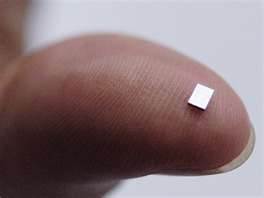By Michael Parker
Food stamp welfare individuals must soon be chipped
“And he causeth all, both small and great, rich and poor, free and bond, to receive a mark in their right hand, or in their foreheads: And that no man might buy or sell, save he that had the mark, or the name of the beast, or the number of his name.” (Revelation 13:16-17)

 Although used in law enforcement and defense for several years, it has recently been used in civilian applications and shows some promise to reduce the number of duplicate cases in the Food Stamp Program (FSP) and other assistance programs .
Although used in law enforcement and defense for several years, it has recently been used in civilian applications and shows some promise to reduce the number of duplicate cases in the Food Stamp Program (FSP) and other assistance programs .
Food stamp welfare individuals must soon be chipped
“And he causeth all, both small and great, rich and poor, free and bond, to receive a mark in their right hand, or in their foreheads: And that no man might buy or sell, save he that had the mark, or the name of the beast, or the number of his name.” (Revelation 13:16-17)
In a little while, the above scene in Revelation 13 will become a global reality. People can no longer buy or sell without the mark of the beast. And sometimes that would mean no longer being able to eat!
The USDA is now considering biometric identification for all individuals who will want to benefit from their Food and Nutrition Services. The RFID chip may just soon be a must for everyone who does not want to starve!
The following is an excerpt of the executive summary of the FINAL REPORT of the Use of Biometric Identification Technology to Reduce Fraud in the Food Stamp Program:
Biometric identification technology provides automated methods to identify a person based on physical characteristics—such as fingerprints, hand shape, and characteristics of the eyes and face—as well as behavioral characteristics—including signatures and voice patterns.
 Although used in law enforcement and defense for several years, it has recently been used in civilian applications and shows some promise to reduce the number of duplicate cases in the Food Stamp Program (FSP) and other assistance programs .
Although used in law enforcement and defense for several years, it has recently been used in civilian applications and shows some promise to reduce the number of duplicate cases in the Food Stamp Program (FSP) and other assistance programs .
Already operational in some states
Biometric identification systems are currently operational at some level in Arizona, California (under county initiative, first by Los Angeles County), Connecticut, Illinois, Massachusetts, New Jersey, New York, and Texas. Finger imaging is the principal form of technology used in all eight States, though alternative technologies have simultaneously undergone trials in Massachusetts (facial recognition) and Illinois (retinal scanning). By the end of 2000, new systems are expected to be in place in California (statewide unified system), Delaware, and North Carolina. Other States are currently in the initial planning stages, including Florida, Maryland, Michigan, Mississippi, Pennsylvania, and South Carolina. However, there is little information available at this point regarding the specific course and trajectory these States will follow in terms of system types, implementation schedules, and the benefit programs in which they will implement the new requirement.
Read more at - http://www.pakalertpress.com/2012/11/26/use-of-rfid-tracking-technology-to-be-mandatory-in-us-food-stamp-program-2/?utm_source=feedburner&utm_medium=email&utm_campaign=Feed%3A+pakalert+%28Pak+Alert+Press%29
Read more at - http://www.pakalertpress.com/2012/11/26/use-of-rfid-tracking-technology-to-be-mandatory-in-us-food-stamp-program-2/?utm_source=feedburner&utm_medium=email&utm_campaign=Feed%3A+pakalert+%28Pak+Alert+Press%29